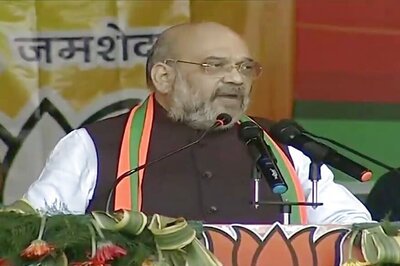
views
Finance Minister Nirmala Sitharaman on Wednesday clarified various allegations by opposition parties on Budget 2024. She said the Budget has taken into consideration all sectors of the economy and every state is allocated sufficient funds.
Speaking on the post-budget discussions in the Rajya Sabha, FM Sitharaman said the Budget is striking a balance with various aspects of growth.
Key Highlights from the Union Budget Discussion
The Finance Minister informed the Rajya Sabha that the total expenditure outlined in the Budget statement amounts to Rs 48.12 lakh crore. She also noted that this figure is Rs 54,744 crore higher than the interim Budget.
She highlighted that the capital expenditure allocation over 10 years under the UPA government was Rs 13.19 lakh crore, whereas under the NDA government up to 2024, it has reached Rs 43.82 lakh crore.
Sitharaman stated that the Budget allocates Rs 1.52 lakh crore to agriculture and allied sectors, an increase of Rs 8,000 crore from the previous year. She contrasted this with the 2013-14 Budget under the UPA government, which allocated only Rs 30,000 crore.
The budget proposed unflinching support to cooperative federalism, funds to states stand at Rs 22.91 lakh crores in FY25, up 2.49 lakh crores YoY, she highlighted.
She added that India on track to attain target of 4.5% fiscal deficit by FY26.
“Budget strikes a fine balance between growth, employment, capital investment, and fiscal consolidation, among others,” she said.
She also mentioned that India now produces 97% of the mobile phones required domestically, and in the year 2023-24, 30% of the total mobile phone production in India was exported.
FM added that the PLI scheme continues to witness a lot of interest from investors.
“We have tried to make India an attractive manufacturing destination,” said FM Sitharaman in reply to a Budget discussion in Rajya Sabha.
FM Sitharaman on Tuesday termed misleading claims by opposition leaders that if any state is not named in the Budget speech, then it does not get any budgetary allocation.
FM Sitharaman informed that India’s inflation in 2022-23 was significantly lower than the global average, while many economies experienced double-digit inflation post-COVID-19.
She attributed this to strategic policies adopted by India to contain inflation, such as the free foodgrain scheme, the offloading of wheat and rice in the open market, price stabilisation funds to maintain a buffer stock of pulses, and the reduction of duty on crude edible oil.
No State Has Been Denied Money in FY25 Budget: Sitharaman
Replying to a Budget discussion in the Lok Sabha, Sitharaman asserted that no state was being denied money.
She recalled that in the past Budgets by the UPA government also did not mention names of all states in their Budget speech.
“I have been picking up on Budget speeches since 2004-2005, 2005-2006, 2006-2007, 2007-2008 and so on. The Budget of 2004-2005 did not take the name of 17 states. I would like to ask the members of the UPA government at that time – did money not go to those 17 states? Did they stop it?” Sitharaman said.
She was responding to comments by several opposition members that the Budget has provided funds only to Bihar and Andhra Pradesh and nothing to other states.
Responding to a remark by TMC leader Saugata Roy that the JNU-educated Finance Minister is “bereft of new ideas”, Sitharaman retorted by saying that even the Chief Minister and Finance Minister of West Bengal have studied from the University of Calcutta (not from Harvard or Oxford).
“I want to ask him, are they too bereft of ideas?” “From the land of Bengal, which gave us ‘Vande Mataram’, today we have Professor Saugata Roy, who remarked that I’m ‘bereft’ of new ideas because I’m from JNU and not Harvard or Oxford… We’re all from Indian Universities, and I want to ask him, in what way, are we less than the Harvards and Oxfords of the world? Even he teaches at an Indian University. He should be ashamed of himself,” the minister said.
To Roy’s remark on inequality in the country, Sitharaman said, “It is a shameful statement to make that inequality was less under British than now”.
She said West Bengal’s share of the total Industrial Production of the country, which used to be 24 per cent at the time of Independence, declined to just 3.5 per cent by 2021.
She also said the government is complying with the fiscal deficit trajectory. It will bring down the deficit to below 4.5 per cent by 2025-26 from the targeted 4.9 per cent for the current fiscal. The deficit was 5.6 per cent in 2023-24. “I am confident of achieving this goal of 4.9 per cent”.
Prime Minister Narendra Modi’s Reaction
After Sitharaman’s reply in the lower House, Prime Minister Narendra Modi, in a post on X, said, “FM @nsitharaman presents a very comprehensive picture of this year’s Budget and what it offers for every section of society. She reiterates our Government’s commitment to growth and reforms”.
Sitharaman said India is the fastest-growing economy globally and has overcome the after-effects of the pandemic due to heavy capex push.
Refuting allegations of the Opposition that the Budget has cut allocation for agriculture, health, education and other social sector, she said allocations on all these heads have gone up compared to the previous year.
Budget 2024-25 is a balance between social objectives and fiscal consolidation, she added.
Stating that fiscal prudence without compromising on welfare schemes is the hallmark of the Modi Government, Sitharaman said that Congress-led UPA used to do off-budget borrowing, and there was a lack of transparency in their budget numbers.
“Lack of transparency was there during UPA, not in the NDA government,” she said.
Giving a comparative analysis of the inflation management during the UPA versus NDA regime, Sitharaman said during the UPA regime, inflation was in double digits for 22 months. Domestic inflation used to be higher than the global average.
However, the NDA government has brought it down to 5.1 per cent in the last 10 years from 8.1 per cent during UPA’s 10-year rule.
She said agriculture allocation was Rs 21,934 crore in 2013-14, which went up 5 times to Rs 1.23 lakh crores in FY25.
More than Rs 3.2 lakh crore has been disbursed to 11 crore farmers under the PM Kisan scheme, she added.
















Comments
0 comment